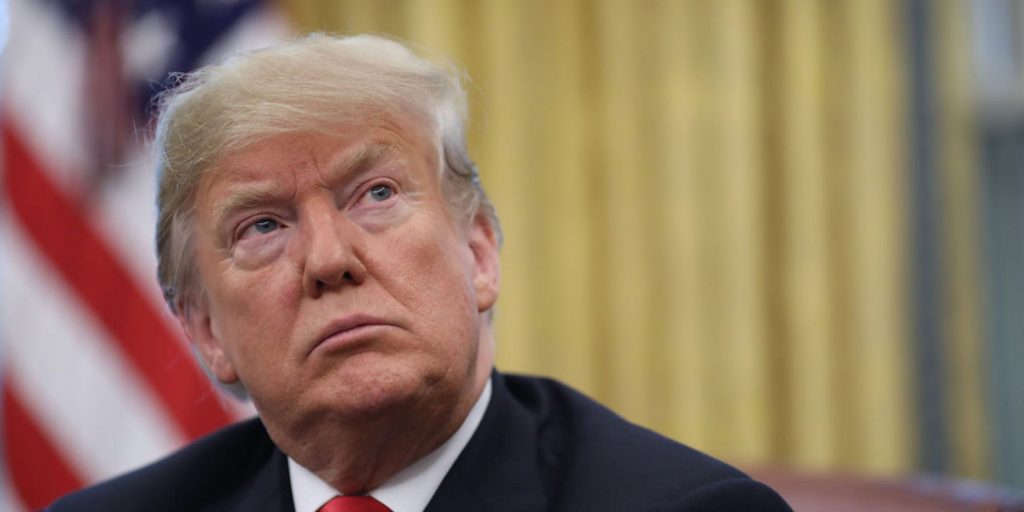
Win McNamee/Getty Images
- Former President Donald Trump began sowing doubt about the 2020 election months before votes were cast.
- After he lost to Joe Biden, Trump tried several methods to overturn the results of the vote.
- A new Senate report released Thursday details how the president and his allies undermined democracy.
A bombshell Senate report published Thursday details the lengths to which former President Donald Trump went in order to, first, sow doubt about the impending 2020 presidential election, and then, overturn the results in the aftermath of his loss.
Of the most substantial revelations is the report's claim that the flailing president made a plan to install a loyalist as acting attorney general to pursue baseless reports of election fraud – a plan that saw top Justice Department officials threaten to resign en masse days before the inauguration, according to the report.
The then-president's efforts to ensure he remained in power began long before a mob of his supporters attacked the Capitol on January 6, and were bubbling beneath the surface before the November election was even held.
Below is an abridged timeline of Trump's efforts to overturn the contentious 2020 election.
September/October 2020:
More than two months before the election, Trump administration Attorney General William Barr falsely claimed on CNN that mail-in voting is ripe for fraud and coercion. The unfounded allegations followed months of similar claims by Barr, including during his July House Judiciary Committee testimony, when he said mail voting creates a "high risk" of voter fraud.
Weeks later, the Department of Justice issued a press release announcing an investigation into nine "discarded" mail-in ballots in Pennsylvania, claiming the majority had been cast for Trump. The department released the statement in spite of a decades-old policy of staying out of election fraud matters, the report said. Days later, the DOJ issued an internal memo announcing an exception to that "general non-interference" policy.
November 2020
The election was held on November 3, 2020, and four days later, several media organizations confirmed that President Joe Biden won both the popular vote and the Electoral College.
In the following days, Trump tweeted several falsehoods, including baseless claims of voter fraud, lies about Dominion Voting Systems, and unfounded allegations of contested states. On November 9, Attorney General Barr weakened the DOJ's election non-interference policy even further.
On November 14, the Trump campaign distributed its own internal memo refuting multiple allegations against the efficacy of the Dominion Voting Systems, which the Senate report said reflected the administration's "early knowledge that such allegations are baseless."
Five days later, Rudy Giuliani and Sidney Powell continued to espouse falsehoods about the election at a press conference at the Republican National Committee.
"I know crimes. I can smell them. You don't have to smell this one. I can prove it to you 18 different ways," Giuliani told the crowd.
December 2020
As the certification of Biden's win drew closer, the then-president's efforts to sow doubt picked up significantly in December.
On December 1, Barr announced that the DOJ had not seen fraud "on a scale that could have effected a different outcome in the election." But Trump's other allies, primarily Giuliani, continued making false claims of fraud, focusing their first efforts on Georgia. The state's Secretary of State Office rebutted the attorney's claim after investigating, despite continued pressure from the president's associates.
On December 4, the Trump campaign along with the chairman of the Georgia Republican Party, filed a suit in Fulton County Superior Court seeking to invalidate the results. One day later, the suit was rejected.
On December 8, the US Supreme Court rejected a separate suit to block Pennsylvania's certification of the results, and three days later, the top court did the same for a suit seeking to overturn results in Georgia, Michigan, Pennsylvania, and Wisconsin.
After then-Senate Majority Leader Mitch McConnell congratulated Biden on his win on December 15, Trump sent a flurry of angry tweets targeting the Republican leader. "Too soon to give up. Republican Party must finally learn to fight. People are angry!" he wrote.
On December 19, Trump tweeted about the upcoming January 6 Joint Session of Congress that would become the infamous Capitol attack.
"Big protests in D.C. on January 6. Be there. Will be wild!"
Following Barr's resignation earlier in the month, Trump asked acting Attorney General Phil Rosen on December 27 to "just say the election was corrupt and leave the rest to me and the Republican Congressmen," according to the Senate report. In the same conversation, Trump brought up possibly replacing Rosen with loyalist attorney Jeffrey Clark.
At the end of the month, Trump held a "contentious" meeting with Rosen and Principal Associate Deputy Attorney General Richard Donoghue, in which he questioned why the DOJ still had not "found the fraud," according to the report. At this meeting, Trump reportedly said he should fire both of them and replace them with his ally, Clark.
January 2021
On January 1, Trump once again tweeted about the upcoming January 6 rally, as the president's allies continued seeking opportunities to "investigate" false election fraud claims throughout the country.
The following day, Trump, along with White House Chief of Staff Mark Meadows and Trump campaign attorney Cleta Mitchell, called Georgia Secretary of State Brad Raffensperger and pressured him to change the state's vote totals in order to "find" enough votes for Trump to win.
During a January 3 meeting, Justice Department senior leadership told Trump that they would resign if the president replaced Rosen with Clark as acting attorney general, but according to the Senate report, the meeting continued for hours before Trump agreed to keep Rosen in his position.
On January 4, Trump, along with outside attorney John Eastman tried to convince then-Vice President Mike Pence to dismiss the Electoral College votes for seven states when he presided over the Joint Session of Congress scheduled for January 6.
As Congress was set to certify the election results, Trump incited his followers many of whom went on to storm the Capitol in an attempt to stop the process. The crowd forced Congress to go into lockdown and damaged the halls of government. More than 650 people have been arrested and charged with crimes in relation to the incident.
On January 20, despite Trump's efforts, Biden was inaugurated as the 46th president.
Thursday's Senate report includes an even more detailed breakdown of the steps Trump took to try and overturn the results.
